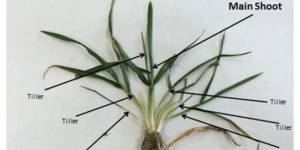How is Your Wheat Crop this Spring?
By Ty Bodeis | March 30, 2022
We will soon be putting winter behind us
The time for wheat stand evaluations will be here. Assessing your wheat stands in the spring is important to ensure you have the potential yield in the field. Several things can affect wheat over the winter from planting date, snow cover and winter temperatures. As is normal with Michigan we had a whole range of conditions depending on where you were located. Here are some of the situations you may run into as you evaluate your winter wheat stands.
If you had large quantities of snow this winter, you may run into ice sheets as that snow is melting. While that snow acted as a great blanket against our cold and windy days it can lead to problems if it melts to fast. If the snow melts steadily without ponding, then you will be in great shape. However, if it melts rapidly, it may pond in the field. This can cause either drowning out the wheat in those areas, or if it freezes again, turn into ice sheets. Ice sheeting and ponding are destructive to wheat in similar ways, by cutting off the air wheat needs to respire, often leading to death of large areas in fields.
Lack of snow cover can also be a problem and if your area did not have much snow then the cold temperatures and wind may have “burnt” the wheat. Snow acts as a blanket to the wheat protecting it from the coldest of temperatures, when the wheat does not have that snow, the cold can damage the wheat. Cold damage appears as yellow and brown leaves giving the wheat the burnt look. If enough leaf tissue is damaged, the wheat can potentially not have enough energy to begin green-up and may die.
Wheat is a durable crop that can handle some of these tough conditions so timing for stand counts is important. Taking stand counts too early can lead to the destruction of a field that has potential for a good yield yet. While waiting too long can mean the application of a fertilizer or chemical is made before a bad stand is evaluated.
The ideal timing of stand counts is ten days to two weeks after green-up begins. That waiting period allows for plants that might have some damage to show signs of recovery. If they are still alive, they will contribute to yield for those acres.
Steps to evaluate your wheat stands.
- Scout your fields. Walk to representative areas of the field. Include the bad and the good areas of production in the field. You know the variability of each field, so be sure to select where your best yield potential is in each field.
- Measure and count the plants and tillers in a square foot. We have one-foot squares available that we use for alfalfa stand counts. You can also reference the chart below to see what your needed number of plants or tillers is for your row spacing and yield potential.
| Row Width | Length of Row Equal to 1 sq. ft. |
| 7” | 20.5” |
| 7.5” | 19.25” |
| 8” | 18” |
| 10” | 14.4” |
- The difference between counting plants and counting tillers can be significant this year.
 If your wheat was planted late last fall because of October weather conditions, it did not get the chance to tiller as much as it normally would in the fall. Wheat still has the potential to tiller in the spring to compensate for that, but earlier applications of nitrogen may be needed to promote tillering.
If your wheat was planted late last fall because of October weather conditions, it did not get the chance to tiller as much as it normally would in the fall. Wheat still has the potential to tiller in the spring to compensate for that, but earlier applications of nitrogen may be needed to promote tillering.
- You can now establish an average yield potential for the field using the chart below. Now consider your past yield history, your current wheat market contracts, input prices and other grain market potential you have and make the most profitable decision for your farm.
| Plants per square foot | Tillers per square foot | Potential Yield %* |
| 30-35 | 90-105 | 100 |
| 24-28 | 72-84 | 100 |
| 18-21 | 54-63 | 90-95 |
| 15-18 | 45-54 | 75-80 |
| 12-14 | 36-42 | 60-70 |
| 6-7 | 18-21 | 40-50 |
If you have questions on your wheat stand this year, we would be happy to help you evaluate your stand. Contact your local DF representative or find your local representative here.
https://ipm.missouri.edu/IPCM/2019/3/winterWheat/
https://www.canr.msu.edu/news/winter_injury_to_winter_wheat_in_michigan
https://www.canr.msu.edu/news/evaluating-wheat-stands-and-spring-management

